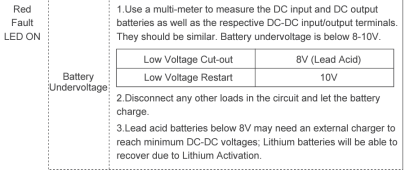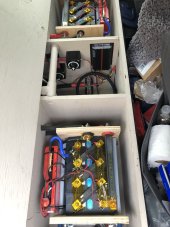OrganicSower
New Member
- Joined
- Nov 19, 2022
- Messages
- 10
As part of my overall system, I'm adding a DC to DC charger to charge my RV's lithiums while driving.
My tow vehicle is a Ram 2500 diesel with the upgraded 220A alternator. Will be running 0/2 cable with an Anderson plug for the RV mounted charger. Lithium battery bank at 900Ah.
So here's my scenario:
Nearly all DC to DC chargers want to read the ignition state of my truck to prevent drawing current when it's off. For example, I will be using the Renogy 60A unit, which takes that approach. However, my concern is that doesn't protect the alternator when the truck is idling or in other situations with low available current that could strain the alternator when the charger is trying to pull a full load.
Rather than reading the ignition state, why not put a Victron BatteryProtect between the starter battery and the DC to DC charger? The wiring is much simplier, but more importantly the BatteryProtect can be set to turn off current flow from the lead acid starter battery when it drops below an appropriate voltage. This would protect the starter battery from being drained while also insuring that the DC to DC charger is only drawing current when the starter battery is in a high charge state.
I then would connect the ignition state wire sensor from the DC to DC charger to the main positive lead from the BatteryProtect, meaning the charger will turn on when the BatteryProtect is sending current and automatically turn off otherwise.
Am I off base in my approach or missing something?
Finally, what BatteryProtect voltage cut off setting would be appropriate coming from the lead acid battery? Cut off current if it drops below a full charge state of 12.6V or something less?
My tow vehicle is a Ram 2500 diesel with the upgraded 220A alternator. Will be running 0/2 cable with an Anderson plug for the RV mounted charger. Lithium battery bank at 900Ah.
So here's my scenario:
Nearly all DC to DC chargers want to read the ignition state of my truck to prevent drawing current when it's off. For example, I will be using the Renogy 60A unit, which takes that approach. However, my concern is that doesn't protect the alternator when the truck is idling or in other situations with low available current that could strain the alternator when the charger is trying to pull a full load.
Rather than reading the ignition state, why not put a Victron BatteryProtect between the starter battery and the DC to DC charger? The wiring is much simplier, but more importantly the BatteryProtect can be set to turn off current flow from the lead acid starter battery when it drops below an appropriate voltage. This would protect the starter battery from being drained while also insuring that the DC to DC charger is only drawing current when the starter battery is in a high charge state.
I then would connect the ignition state wire sensor from the DC to DC charger to the main positive lead from the BatteryProtect, meaning the charger will turn on when the BatteryProtect is sending current and automatically turn off otherwise.
Am I off base in my approach or missing something?
Finally, what BatteryProtect voltage cut off setting would be appropriate coming from the lead acid battery? Cut off current if it drops below a full charge state of 12.6V or something less?







